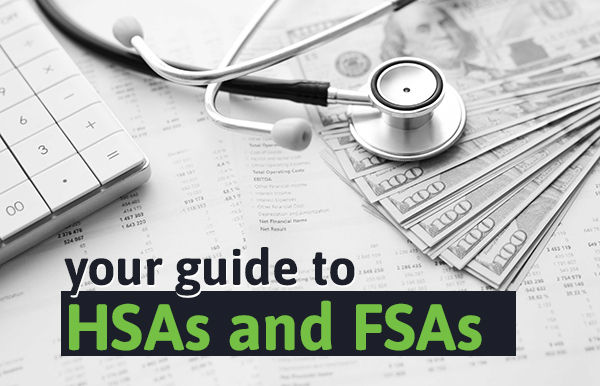Introduction: What are HSAs and FSAs?
HSAs are Health Savings Accounts and FSAs are Flexible Spending Accounts. They are two types of healthcare fund accounts designed to cover out-of-pocket medical or medically-related expenses not included or covered by an individual's health insurance plan. Because of how these accounts are funded (with pre-tax dollars), they offer potential savings to their account holders if utilized correctly.
We've created the following guide to help you understand the advantages and differences between these two types of health care savings accounts.

How HSAs and FSAs are Funded
Both Health Savings Accounts and Flexible Spending Accounts are funded similarly. Employees, their employers, or a combination of both can fund the accounts up to their limits per year. The funds contributed by the employee are added on a pre-tax basis, meaning they are withheld from the employee's gross wages and can offer them potential income tax savings.
If funded by the employee, both FSAs and HSAs are typically paid for with payroll contributions distributed per pay period throughout the year to equal the amount set by the employee when enrolling. For example, if an employee who is paid twice a month signed up to add $500 to either an FSA or HSA account, then $20.83 would be deduced from each paycheck to contribute to their FSA or HSA account.
The Funding Limits
The yearly funding limits of FSAs (for 2022) are $2,850 per year, per employee, according to healthcare.gov. Your spouse can also have their own account with the same limit of $2,850 for themselves as well. Each employee must determine their contribution amount at the time of sign up, as it cannot be changed throughout the year unless there is a significant family status change (such as a marriage, new child, etc.), then they can submit for an adjustment.
The individual funding limits for HSAs have a yearly maximum of $3,650 for individuals or $7,300 for family coverage. Individuals over 55 years old can contribute an additional $1,000. Contributing employees can change their contribution amounts at any time throughout the year so long as they do not exceed the account limits.
Account Balance Carry-Over
Some FSA accounts allow a carry-over of up to $570 for the following year, while some do not allow any funds to carry over into the next year. HSA funds, on the other hand, roll over from year to year, allowing your account to grow if not fully used.
FSA funds are technically owned by the employer. Unused funds in an FSA account not used by the end of the year (or grace period if allowed) deadline are "lost" and cannot be used by the employee. HSA funds, on the other hand, are owned by the employee and their accounts stay with them even if they quit their job.
Eligible Expenses
Both FSA and HSA accounts can be used for the same IRS eligible expenses. These include things like medical and dental co-pays or deductibles, orthodontics, certain medical supplies or equipment, and qualifying prescriptions and over the counter medications. For a full list of what the funds can be used for, refer to this IRS publication.
Accessing Funds
With an FSA account you can access the amount you've signed up for early as the beginning of the year, even if you haven't contributed the full amount yet. For example, if you sign up for $2,500 to pay for braces, you can use all $2,500 for an orthodontic appointment in January even if you won't have contributed the full amount from your paycheck deductions until the end of the year.
HSAs, in contrast, only permit you to access funds that you've already contributed up to that point.
Participation Eligibility
HSA accounts are only available to employees who also participate in a high deductible HDHP qualifying health insurance plan. The deductible of the plan needs to be at least $1,400 for themselves or $2,800 for their family, but the annual out-of-pocket can't exceed $7,000 (for individuals) or $14,000 (for families). Employees can contribute to an FSA account regardless of what type of health insurance plan they participate in (it can be an HDHP or not). Some employers, however, will only allow you to contribute to an FSA if you are ineligible to contribute to an HSA.
If either of these medical plans seem like they would be a good fit for your financial and medical situation, talk to your employer today and find out when and if you are eligible to enroll.
